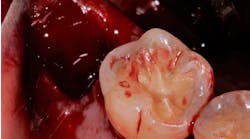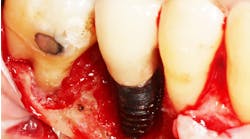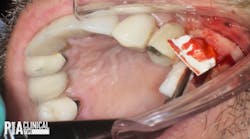Atypically prolonged pain after dentoalveolar surgery: A study of tricyclic antidepressants
Background: Atypical pain perceived by patients undergoing dentoalveolar surgical trauma is not a well-understood issue. A patient’s perception of prolonged pain, which is not resolved by antibiotics, anti-inflammatory agents, or analgesics becomes grounds for patient and practitioner frustration. Often, these patient frustrations become a playground for attorneys to investigate. This paper brings to the forefront the use of tricyclic antidepressants (TCA) to aid both practitioner and patient in resolving the atypical, peripheral chronic pain issue.
Clinical implications: The use of tricyclic antidepressants in the practice of clinical dentistry is unprecedented and merits continued clinical investigative research.
Dental discomfort caused by local anesthetic procedures is a well-documented side effect of soft and hard tissue periodontal and oral surgery. Prior to the onset of the surgical procedure, patients are advised of the potential of side effects such as bleeding, swelling, discomfort, and infection. In order to minimize the side effects, patients are prescribed antibiotics, analgesics, anti-inflammatory and topical drug agents. This group of medications commonly helps control the above side effects and allows for a comfortable postoperative experience.
ADDITIONAL READING |A novel non-narcotic approach to pain management: By the clock
On occasion, a patient may develop discomfort that continues for weeks or months after a local anesthetic, soft or hard tissue surgery, resulting in a very unhappy patient and a bewildered surgeon. The dental surgeon may prescribe more anti-inflammatory medication, with the thought of continuing to reduce or remove the foci of inflammation subsequent to the procedure. These foci of inflammation appear to cause lingering, somewhat bizarre discomfort that become frustrating for both practitioner and patient due to the apparent lack of etiology.
In medicine, practitioners have utilized various other medications in order to resolve the lingering pain a patient develops following surgical trauma to a local site, or treatment of other pain-associated chronic disorders such as rheumatoid arthritis, dysmenorrhea, menopause, neuropathic pain, fibromyalgia, and post-traumatic stress disorder.(1,2,3)
Tricyclic antidepressants (TCAs) have been used for control or complete resolution of chronic pain since the mid-1950s. TCAs are primarily used in the clinical treatment of mood disorders, post-traumatic stress disorder (PTSD), chronic pain, and neuropathic pain. (4)
Amitriptyline, originally developed by Merck Industries, was synthesized in 1960 and subsequently approved by the United States Food and Drug Administration (FDA) in April 1961. Amitriptyline is classified on the World Health Organization’s List of Essential Medicines, a list of most important medications necessary in our basic health-care system. (5)
Amitriptyline is absorbed in the gastrointestinal tract and metabolized in the liver. It is 96% plasma protein bound and subsequently excreted in the urine, approximately 50% and a smaller amount in the feces.(6,7)
In the United States, amitriptyline is commonly prescribed under the brand names Elavil and Levate. It primarily acts a serotonin-norepinephrine reuptake inhibitor, with significant effects on serotonin transporter and more moderate effects on the norepinephrine transporter. Amitriptyline is metabolized to nortriptyline, a more potent norepinephrine uptake inhibitor. (7)
Amitriptyline is an effective medication for the treatment of peripheral and diabetic neuropathies. It has been proven to be effective in relieving such pain in 75% of the patients treated. The TCA has been prescribed in a low dose, short-term manner for other conditions besides depression, including relief of chronic pain, due to its analgesic effects.
Neuropathy refers to a misfiring of nerve tissue that often leads to painful symptoms. Many disorders may cause neuropathy, diabetes, shingles, cancer, autoimmune disorders, in addition to tissue trauma. TCAs may be utilized in relieving the pain issues in the above disorders or trauma. TCAs are used for neuropathy with success due to their noradrenergic and serotonergic reuptake inhibitor. More simply, amitriptyline causes “good feeling” neurotransmitters in the brain to stop the reabsorption of these by brain cells. These neurotransmitters remain at high levels in the blood, resulting in mood elevation and pain cessation.(8,9)
In the field of dentistry and, more specifically, surgical implant placement, amitriptyline has been found to be very effective in reducing and eliminating pain caused by the trauma of the procedure. The lingering pain phenomenon this paper describes is rare, but very real to the patients who experience it.
Drug side effects of amitriptyline include drowsiness (thus patients are advised to take the low dose at bedtime), dry mouth, blurred vision, or trouble with urination. (10) Patients, of course, are advised to contact the prescribing practitioner and physician if side effects do occur.
The local drug activity at the site of inflammation or pain is still not completely understood. TCAs have been used to treat mild to moderate pain associated with neuropathy for more than 20 years. They work by increasing the level of neurotransmitter in brain tissue and inhibiting the chemical processes in the brain that enable you to feel pain. These drugs are often used in combination with non-narcotic or narcotic pain relievers. (11)
Neuropathic pain generally responds more rapidly than depression to TCAs; i.e., three to 10 days vs. 14 to 28 days.
This paper recommends the low dose of amitriptyline, 25 mg — one dose at bedtime — for a period of 14 to 45 days. All patients were advised as to the possible common side effects of the TCA and were given the option to stop the medication at any time, if they experienced any symptoms that made them uncomfortable. Any patient was asked to notify us if indeed the medication was stopped. The dosage recommended for amitriptyline utilized for treatment of pain is much lower than TCA use in treatment of depression. All subjects described in the present paper were not prescribed the above medication for more than 45 days.
The current authors most often utilize a methyl prednisone following the patient’s complaint that the discomfort or pain is lingering and never reaches an end point. Subsequently, amitriptyline is prescribed at a low dose for no longer than 45 days, with complete cessation of pain. Eleven patients have been followed, with one patient refusing to comply with the TCA prescription.
Our experience with the use of amitriptyline for treatment of bizarre, lingering pain has been overwhelmingly positive. We strongly recommend discussing the prescription use with the treating physician and pharmacist. All nondental practitioners and pharmacists were very supportive of the use of this TCA, as it has been demonstrated to be significantly effective with other chronic pain symptomology associated with other systemic disorders or trauma.
Salvatore Termini, DDS, is an oral and maxillofacial surgeon with medical licenses in the states of Illinois, Wisconsin, and Texas. He earned his Doctor of Dental Surgery at Northwestern University Dental School in 1993 and had his postgraduate training at Cook County Hospital and Evanston-Glenbrook Hospital. In 2003, he earned his Diplomate of the American Board of Oral and Maxillofacial Surgery board certification. Dr. Termini has been involved in numerous lectures though OMFS Resident Lecture Series in Chicago and is also a member of many professional organizations, including the Chicago Dental Society, Arcolian Dental Arts Society, Illinois Society of Oral and Maxillofacial Surgeons, and many more. He is a published author and continues to keep his specialty knowledge current through continuing education. His special interests include treatment of facial trauma, jaw reconstruction, sinus grafting, and researching maxillofacial traumatology and minimally invasive treatments. Dr. Termini is on the attending staff at Rush University Medical Center.
References
1. Sindrup SH, Otto M, Finnerup B, et al. Antidepressants in treatment of neuropathic pain. Basic Clin Pharmacol Toxicol 2005;96:399-409.
2. Arnold LM. Duloxetine and other antidepressants in the treatment of patients with fibromyalgia. Pain Med 2007;8:63-74.
3. Miller A, Rabe-Jablonska J. The effectiveness of antidepressants in the treatment of chronic noncancer pain — a review. Psychiatry Pol 2005;39:21-32.
4. Ban, TA. In memory of three pioneers. 2006;9:475-477.
5. Fangman P, Assior HJ, Gonzalez CA, et al. Half a century of antidepressant drugs: On the clinical introduction of monoamine oxidase inhibitors, tricyclics, and tetracyclics. Part II. Triclyclics and tetracyclics. J CL Psychopharm 2008;28:1-4.
6. Amitriptyline. Martindale. The complete drug reference (London;UK Pharmaceutical press) 2013;30.
7. Levate (amitriptyline), dosing, indications, interactions, adverse effects, and more. Medscape reference. Web MD, retrieved December 2013.
8. Baron R. Mechanism of disease; neuropathic pain — a clinical perspective. Nat Clin Pract Neurol 2006;2:95-106.
9. Liu B, Andersen G, Mittman N, et al. Use of selective serotonin-reuptake inhibtors or tricyclic antidepressants and risk of hip fracture in elderly people. Lancet 1998;351:1303-1307.
10. McConaghy N, Joffe AD, Kingston WR, et al. Correlation of clinical features of depressed outpatients in response of amitriptyline and protriptyline. Br J Psychiatry 1968;114:103-106.
11. Klerman GL, Cole JO. Clinical pharmacology of imipramine and related antidepressant compounds. Int J Psychiatry 1976;3:267-304.










